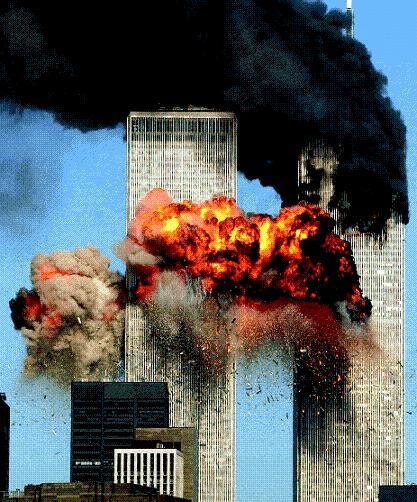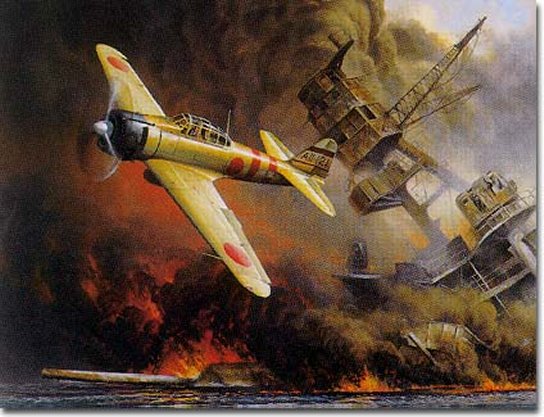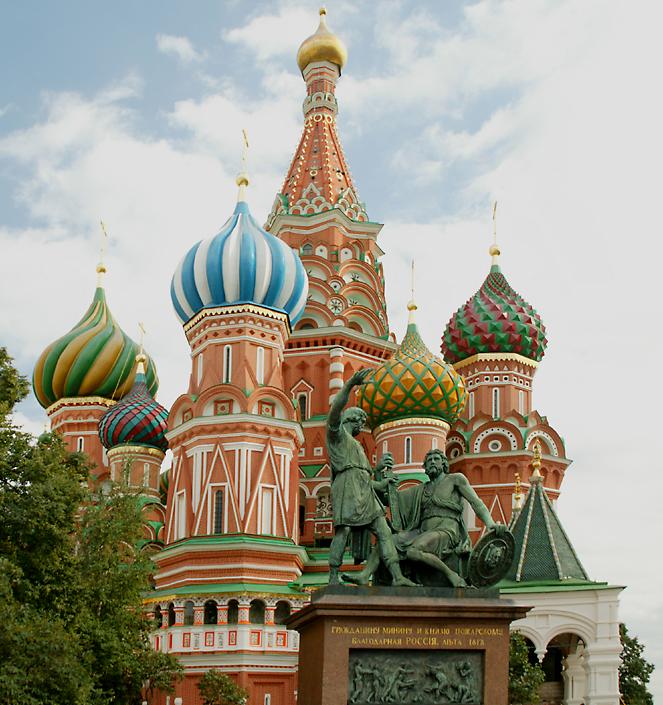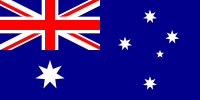1.The Pacific War was the part of World War II—and preceding conflicts—that took place in the Pacific Ocean, its islands, and in the Far East. The war began as a conflict between the Empire of Japan and the Republic of China on July 7, 1937, but by December 1941, became part of the greater World War II, and lasted until August 14, 1945. The Pacific War saw the Allied powersagainst the Empire of Japan, the latter aided by Thailand and to lesser extent by its Axis allies Germany and Italy. The most decisive actions took place after the Empire of Japan attacked various countries, most notably the bombing of Pearl Harbor in the United States' Territory of Hawaii. The Pacific War culminated in the atomic bombings of Hiroshima and Nagasaki by the United States and the Soviet invasion of Manchuria, resulting in Victory over Japan Day and the end of World War II on August 15, 1945. The Surrender of Japan occurred aboard the battleship USS Missouri on September 2, 1945.
http://en.wikipedia.org/wiki/Pacific_War 16.02.10

Picture http://www.pacificwar.org.au/webgraphics/Famousfour_small.jpg 16.02.10
2. The assassination of John F. Kennedy, the thirty-fifth President of the United States, took place on Friday, November 22, 1963, in Dallas,Texas, at 12:30 p.m. Central Standard Time (18:30 UTC) in Dealey Plaza. Kennedy was fatally shot while riding with his wife Jacqueline in a Presidential motorcade.
Just before 12:30 p.m. CST, Kennedy’s limousine entered Dealey Plaza and slowly approached the Texas School Book Depository. Nellie Connally, then the First Lady of Texas, turned around to Kennedy, who was sitting behind her, and commented, "Mr. President, you can't say Dallas doesn't love you," which President Kennedy acknowledged.
When the Presidential limousine turned and passed the Depository and continued down Elm Street, shots were fired at Kennedy; a clear majority of witnesses recalled hearing three shots. A minority of the witnesses did recognize the first gunshot blast they heard as a weapon blast, but there was hardly any reaction from a majority in the crowd or riding in the motorcade itself to the first shot, with many later saying they heard what they first thought to be a firecracker or the exhaust backfire of a vehicle just after the president started waving.
http://en.wikipedia.org/wiki/November_22,_1963 16.02.10

Picture: http://chictrib.image2.trb.com/chinews/media/photo/2008-01/34573215.jpg 16.02.10
3. The September 11 attacks (often referred to as September 11th or 9/11) were a series of coordinated suicide attacks by al-Qaeda upon the United States on September 11, 2001. On that morning, 19 al-Qaeda members hijacked four commercial passenger jet airliners.[1][2] The hijackers intentionally crashed two of the airliners into the Twin Towers of the World Trade Centerin New York City, killing everyone on board and many others working in the buildings. Both buildings collapsed within two hours, destroying nearby buildings and damaging others. The hijackers crashed a third airliner into the Pentagon in Arlington, Virginia, just outside Washington, D.C. The fourth plane crashed into a field near Shanksville in rural Pennsylvania after some of its passengers and flight crew attempted to retake control of the plane, which the hijackers had redirected toward Washington, D.C. There were no survivors from any of the flights.
2,973 victims and the 19 hijackers died as a result of the attacks. The overwhelming majority of casualties were civilians, including nationals of over 90 countries. In addition, the death of at least one person from lung disease was ruled by a medical examiner to be a result of exposure to dust from the World Trade Center's collapse.
The United States responded to the attacks by launching the War on Terrorism. It invaded Afghanistan to depose the Taliban, who had harbored al-Qaeda terrorists. The United States also enacted the USA PATRIOT Act. Many other countries also strengthened their anti-terrorism legislation and expanded law enforcement powers. Some American stock exchanges stayed closed for the rest of the week following the attack and posted enormous losses upon reopening, especially in the airline and insurance industries. The destruction of billions of dollars worth of office space caused serious damage to the economy of Lower Manhattan.
The damage to the Pentagon was cleared and repaired within a year, and the Pentagon Memorial was built on the site. The rebuilding process has started on the World Trade Center site. In 2006 a new office tower was completed on the site of 7 World Trade Center. 1 World Trade Center is currently under construction at the site and, at 1,776 ft (541 m) upon completion in 2013, it will become one of the tallest buildings in North America. Three more towers were originally expected to be built between 2007 and 2012 on the site. Ground was broken for the Flight 93 National Memorial on November 8, 2009, and the first phase of construction is expected to be ready for the 10th anniversary of the attacks on September 11, 2011.
http://en.wikipedia.org/wiki/9/11 16.02.10

Picture: http://preparednesspro.files.wordpress.com/2009/09/the-next-9-11.jpg 16.02.10
Theories of September 11: http://www.popularmechanics.com/technology/military_law/1227842.html?page=1 16.02.10
4. The RMS Titanic was an Olympic-class passenger liner owned by the White Star Line and was built at the Harland and Wolffshipyard in Belfast, in what is now Northern Ireland. At the time of her construction, she was the largest passenger steamship in the world.
Shortly before midnight on 14 April 1912, four days into the ship's maiden voyage, Titanic struck an iceberg and sank two hours and forty minutes later, early on 15 April 1912. The sinking resulted in the deaths of 1,517 of the 2,223 people on board, making it one of the deadliest peacetime maritime disasters in history. The high casualty rate was due in part to the fact that, although complying with the regulations of the time, the ship did not carry enough lifeboats for everyone aboard. The ship had a total lifeboat capacity of 1,178 people, although her maximum capacity was 3,547. A disproportionate number of men died due to the women and children first protocol that was followed.
The Titanic was designed by some of the most experienced engineers, and used some of the most advanced technologies available at the time. It was popularly believed to have been unsinkable. It was a great shock to many that, despite the extensive safety features, the Titanic sank. The frenzy on the part of the media about Titanic's famous victims, the legends about the sinking, the resulting changes to maritime law, and the discovery of the wreck have contributed to the continuing interest in, and notoriety of, the Titanic.
Once the massive loss of life became clear, White Star Line chartered the cable ship CS Mackay-Bennett from Halifax, Nova Scotia to retrieve bodies. Three other ships followed in the search, the cable ship Minia, the lighthouse supply ship Montmagny and the sealing vessel Algerine. Each ship left with embalming supplies, undertakers, and clergy. Of the 333 victims that were eventually recovered, 328 were retrieved by the Canadian ships and five more by passing North Atlantic steamships. For some unknown reason, numbers 324 and 325 were unused, and the six passengers buried at sea by the Carpathia also went unnumbered. In mid-May 1912, over 200 miles (320 km) from the site of the sinking, theOceanic recovered three bodies, numbers 331, 332 and 333, who were occupants of Collapsible A, which was swamped in the last moments of the sinking. Several people managed to reach this lifeboat, although some died during the night. When Fifth Officer Harold Lowe rescued the survivors of Collapsible A, he left the three dead bodies in the boat: Thomas Beattie, a first-class passenger, and two crew members, a fireman and a seaman. The bodies were buried at sea from Oceanic.
In many locations there are memorials to the dead of the Titanic. In Southampton, England a memorial to the engineers of the Titanic may be found in Andrews Park on Above Bar Street. Opposite the main memorial is a memorial to Wallace Hartley and the other musicians who played on the Titanic. A memorial to the ship's five postal workers, which says "Steadfast in Peril" is held by Southampton Heritage Services.
Contrary to popular mythology, the Titanic was never described as "unsinkable", without qualification, until after she sank. There are three trade publications (one of which was probably never published) that describe the Titanic as unsinkable, prior to her sinking, but there is no evidence that the notion of the Titanic's unsinkability had entered public consciousness until after the sinking.
http://en.wikipedia.org/wiki/Titanic#Survivors.2C_victims_and_statistics 16.02.10

Picture:
http://students.umf.maine.edu/~hartwenr/webquest/Webquesthome/Titanic%20BW.gif 16.02.10
5. The Mayflower was the ship that transported the English Separatists, better known as the Pilgrims, from Plymouth, England, toPlymouth, Massachusetts, United States (which would become the capital of Plymouth Colony), in 1620. There were 102 passengers and a crew of 25–30.
The vessel left England on September 6, 1620 (Old Style)/September 16 (New Style), and after a grueling 66-day journey marked by disease, which claimed two lives, the ship dropped anchor inside the hook tip of Cape Cod (Provincetown Harbor) on November 11/November 21. The Mayflower was originally destined for the mouth of the Hudson River, near present-day New York City, at the northern edge of England's Virginia colony, which itself was established with the 1607 Jamestown Settlement. However, theMayflower went off course as the winter approached, and remained in Cape Cod Bay. On March 21/31, 1621, all surviving passengers, who had inhabited the ship during the winter, moved ashore at Plymouth, and on April 5/15, the Mayflower, a privately commissioned vessel, returned to England. In 1623, a year after the death of captain Christopher Jones, the Mayflower was most likely dismantled for scrap lumber in Rotherhithe, London.
The Mayflower has a famous place in American history as a symbol of early European colonization of the future US. With their religion oppressed by the English Church and government, the small party of religious Puritan separatists who comprised about half of the passengers on the ship desired a life where they could practice their religion freely. This symbol of religious freedom resonates in US society and the story of the Mayflower is a staple of any American history textbook. Americans whose roots are traceable back to New England often believe themselves to be descended from Mayflower passengers.
http://en.wikipedia.org/wiki/Mayflower 16.02.10

Picture: http://samuelatgilgal.files.wordpress.com/2008/11/mayflower.jpg 16.02.10
History: http://www.mayflowerhistory.com/ 16.02.10
6. The Apollo 11 mission landed the first humans on the Moon. Launched on July 16, 1969, the third lunar mission of NASA's Apollo Programwas crewed by Commander Neil Alden Armstrong, Command Module Pilot Michael Collins, and Lunar Module Pilot Edwin Eugene 'Buzz' Aldrin, Jr. On July 20, Armstrong and Aldrin became the first humans to land on the Moon, while Collins orbited in the Command Module.
The mission fulfilled President John F. Kennedy's goal of reaching the moon by the end of the 1960s, which he had expressed during a speechgiven before a joint session of Congress on May 25, 1961: "I believe that this nation should commit itself to achieving the goal, before this decade is out, of landing a man on the Moon and returning him safely to the Earth."
http://en.wikipedia.org/wiki/Apollo_11 16.02.10

Picture: http://blog.scad.edu/acalibrary/files/2009/07/apollo11.jpg 16.02.10
http://www.youtube.com/watch?v=pCp2jTtay0w 17.02.10
The Apollo Program: http://blog.scad.edu/acalibrary/files/2009/07/apollo11.jpg 16.02.10
7. The inauguration of Barack Obama as the 44th President of the United States took place on Tuesday, January 20, 2009. Theinauguration, which set a record attendance for any event held in Washington, D.C., marked the commencement of the four-year term of Barack Obama as President and Joseph Biden as Vice President. Based on the combined attendance numbers, television viewership and Internet traffic, it was among the most observed events ever by the global audience.
"A New Birth of Freedom", a phrase from the Gettysburg Address, served as the inaugural theme to commemorate the 200th anniversary of the birth year of Abraham Lincoln. In his speeches to the crowds, Obama referred to ideals expressed by Lincoln about renewal, continuity and national unity. Obama mentioned these ideals in his speech to stress the need for shared sacrifice and a new sense of responsibility to answer America's challenges at home and abroad.
Obama and others paid homage to Lincoln in the form of tributes and references during several of the events, starting with a commemorative train tour from Philadelphia, Pennsylvania to Washington, D.C. on January 17, 2009. The inaugural events held in Washington, D.C. from January 18 to January 21, 2009 included concerts, a national day of community service on Martin Luther King, Jr. Day, the swearing-in ceremony, luncheon and parade, inaugural balls, and the interfaith inaugural prayer service. Thepresidential oath as administered to Obama during his swearing-in ceremony on January 20 strayed from the oath of office prescribed in the United States Constitution, which led to its re administration the next evening.
http://en.wikipedia.org/wiki/Inauguration_of_Barack_Obama 16.02.10

Picture: http://monterrey.usconsulate.gov/uploads/images/M9bzXFbOzKh7QaMYXiY2-g/Barack_Obama.jpg 16.02.10
http://www.youtube.com/watch?v=Hde4s-xBhqE&feature=fvst 16.02.10
Webpage: http://www.whitehouse.gov/administration/president-obama 16.02.10
8. The precursor to the Internet, ARPANET was a large wide-area network created by the United States Defense Advanced Research Project Agency (ARPA). Established in 1969, ARPANET served as a testbed for new networking technologies, linking many universities and research centers. The first two nodes that formed the ARPANET were UCLA and the Stanford Research Institute, followed shortly thereafter by the University of Utah.
Tim Berners-Lee is the primary inventor of the World Wide Web, the system of text links and multimedia capabilities that made the Internet accessible to mass audiences. Lee wrote the original Web software himself in 1990 and made it available on the Internet in 1991. He joined MIT's Laboratory for Computer Science in 1994 and remains a leading authority on Internet issues. His 1999 book Weaving the Webdescribed the Web's birth and growth. In 2003, Queen Elizabeth II announced that Berners-Lee would be made a Knight Commander of the Order of the British Empire (KBE) for his work on the Web.
http://www.webopedia.com/TERM/A/ARPANET.html 16.02.10
http://www.who2.com/ask/timbernerslee.html 16.02.10

Picture: http://www.edwardsamuels.com/ILLUSTRATEDSTORY/chapter%205/berners-lee.jpg 16.02.10
9. "September 1, 1939" is a poem by W. H. Auden written on the occasion of the outbreak of World War II. It was first published in The New Republic issue of October 18, 1939, and was first published in book form in Auden's collection Another Time.
The poem deliberately echoes the stanza form of W. B. Yeats's "Easter, 1916", another poem about an important historical event, and, like Yeats' poem, Auden's moves from a description of historical failures and frustrations to a possible transformation in the present or future.
Until the two final stanzas, the poem briefly describes the social and personal pathology that has brought about the outbreak of war: first the historical development of Germany "from Luther until now", next the internal conflicts in every individual person that correspond to the external conflicts of the war. Much of the language and content of the poem echoes that of C. G. Jungin his book Psychology and Religion (1938).
The final two stanzas shift radically in tone and content, turning to the truth that the poet can tell, "We must love one another or die," and to the presence in the world of "the Just" who exchange messages of hope. The poem ends with the hope that the poet, like "the Just", can "show an affirming flame" in the midst of the disaster.
Despite Auden's disapproval, the poem became famous and widely popular. E. M. Forster wrote "Because he once wrote 'We must love one another or die' he can command me to follow him" (Two Cheers for Democracy, 1951).
A close echo of the line "We must love one another or die", spoken by Lyndon Johnson in a recording of one of his speeches, was used in the famous Johnson campaign commercial "Daisy" during the 1964 campaign. In the ad, the image of a young girl picks petals from a daisy, then is replaced by the image of a nuclear detonation, which serves as an apocalyptic backdrop to the audio of Johnson's speech. Johnson's version of the line, inserted into a speech by an unidentified speechwriter, was "We must love each other, or we must die."
In 2001, immediately after the September 11, 2001 terrorist attacks, the poem was read (with many lines omitted) on National Public Radio and was widely circulated and discussed for its relevance to recent events.
http://en.wikipedia.org/wiki/September_1,_1939 16.02.10
Poem: http://www.poemdujour.com/Sept1.1939.html 16.02.10
10. The attack on Pearl Harbor (or Hawaii Operation, Operation Z, as it was called by the Japanese Imperial General Headquarters, and Battle of Pearl Harbor by some Americans) was an unannounced military strike conducted by the Japanese navy against the United States naval base at Pearl Harbor, Hawaii on the morning of December 7, 1941. It resulted in the United States' entry into World War II. The attack was intended as a preventive action in order to keep the U.S. Pacific Fleet from influencing the war that the Empire of Japan was planning in Southeast Asia, against Britain and the Netherlands, as well as the U.S. in thePhilippines. The attack consisted of two aerial attack waves totaling 353 aircraft, launched from six Japanese aircraft carriers.
The surprise was complete. The attacking planes came in two waves; the first hit its target at 7:53 AM, the second at 8:55. By 9:55 it was all over. By 1:00 PM the carriers that launched the planes from 274 miles off the coast of Oahu were heading back to Japan.
Behind them they left chaos, 2,403 dead, 188 destroyed planes and a crippled Pacific Fleet that included 8 damaged or destroyed battleships. In one stroke the Japanese action silenced the debate that had divided Americans ever since the German defeat of France left England alone in the fight against the Nazi terror.
Approximately three hours later, Japanese planes began a day-long attack on American facilities in the Philippines. (Because the islands are located across the International Dateline, the local Philippine time was just after 5 AM on December 8.) Farther to the west, the Japanese struck at Hong Kong, Malaysia and Thailand in a coordinated attempt to use surprise in order inflict as much damage as quickly as possible to strategic targets.
http://en.wikipedia.org/wiki/December_7,_1941 16.02.10
http://www.eyewitnesstohistory.com/pearl.htm 16.02.10

Picture: http://www.theodoresworld.net/pics/1208/attackImage4.jpg 16.02.10







































